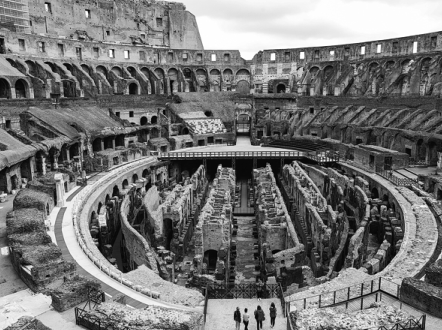It's all looking up for Rome's Colosseum

ROME-Italy's culture minister announced the winning bid to restore the Colosseum's arena on Sunday, a project that will allow visitors to view the archaeological wonder from ground level as soon as 2023.
The 2,000-year-old structure is currently floorless, the ruins of the underground levels' walls and tunnels exposed to the open air save for a small platform.
A Milan engineering firm beat 10 competitors that answered a 2020 call for submissions with its vision involving rotating wooden slats that would allow natural ventilation and lighting of the lower levels.
"It's another step forward toward rebuilding the arena, an ambitious project that will aid the conservation of the archaeological structures while getting back to the original image of the Colosseum and its quality as a complex scenographic machine," Culture Minister Dario Franceschini said.
With the new floor, visitors to the Colosseum will be able to admire the treasured monument from the center of the arena-a view once reserved for gladiators and slaves as they prepared to meet their doom.
It also will permit the staging of cultural events that are respectful of the Colosseum as a symbol of Italy, Franceschini said.
Italy plans to host the Rome G20 culture summit at the Colosseum in July and it may serve as a venue for other major cultural events.
The Colosseum's executive archaeologist Alfonsina Russo said construction at the arena-which will be the subject of a Europe-wide call for bids of about 15 million euros ($18 million)-should begin by the end of the year or early 2022.
Ready in 2023
She said the new 3,000-square-meter floor should be ready for visitors in 2023.
Before the pandemic, around 25,000 people toured the world-famous monument daily, and nearly 18.5 million euros have been set aside for the project.
The plan presented on Sunday consists of an entirely removable structure made of accoya, a modified, durable wood.
The slats will be rigged with a rotation system meant to permit light and air to circulate to underground passages below the area.
The rain water that currently pools there will be collected and used to supply the toilets of Rome's most visited monument.
The Colosseum reopened to the public last week after a 41-day closure because of rolling pandemic restrictions. Officials have set up a one-way itinerary as part of safety measures, and visitors are limited to 1,260 a day, compared with as many as 25,000 a day in 2019, before the pandemic.
Agencies Via Xinhua

Today's Top News
- Lawmakers review draft law to expand childcare services
- China's new-style tea brands find a hot new market in US
- Xi extends congratulations to Chilean president-elect
- Japan urged to stop provocative moves
- Shanxi ends province-wide blanket fireworks ban
- Tech park set to lift GBA's development






























